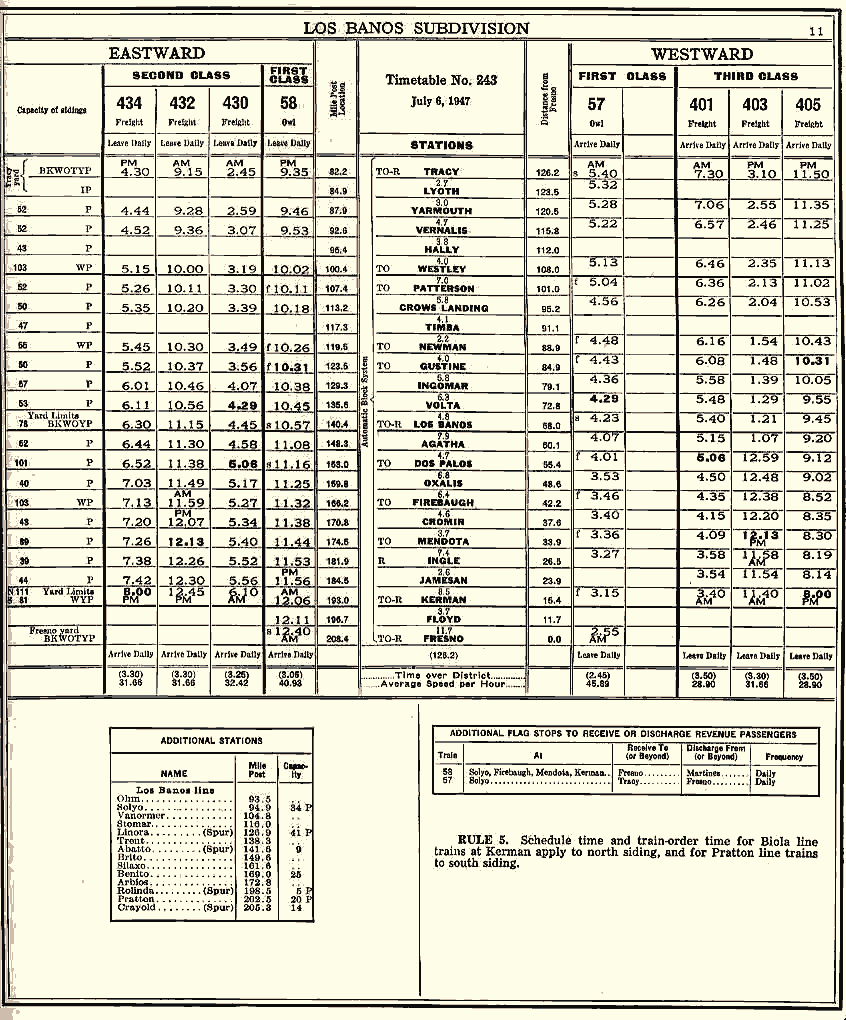The Timetable & Special Instructions
The Timetable
Knowing what you do thus far about the Movement of Trains, you probably have developed a new appreciation for the enormous amount of vital information contained in your average employee timetable, and likewise fathom some of its practical applications. Let's further decipher some of the more important things.
Superiority of Trains: The Western Division's Timetable Special Instructions (TTSI) (as well as most of SP at the time) stipulates under Rule S-72 that westward trains of the same class are superior, but note that, on the Los Banos Sub, all west freight trains are third class, while all east freights are second class. Conversely, west extra trains still are superior to east extras. This situation probably was due to the prevailing direction of loaded traffic.
Notice also, that some schedule times are printed in bold. These are scheduled meeting points between regular trains. For example, #405's time at Gustine is 10:31pm, and looking at the eastward trains columns, you'll see that it is scheduled to meet #58, the Owl. We surely know who will head into the hole.
(continued below)
Cryptic letters: The timetable page contains considerable shorthand in the form of alphabet letters. Here's what they mean:
Station Column
- TO and TO-R: Train Order and Train Order-Train Register stations. At these locations, crews must be ready to receive TO's, unless the TTSI or a TO says otherwise for a specific location Often TO offices are only open during daylight hours, when the station agent doubles as the train order operator. Likewise, a west train at Dos Palos may receive an order stating "Do not obtain clearance at Los Banos." At register staions the conductor must register their train in person, or by register ticket. This requirement may also be obvaited by train order: "Do not register at Los Banos."
- D.T.: double track territory; train order authority usually not required
- C.T.C.: centralized traffic control territory, with some switches/signals controlled by the train dispatcher; train order authority not required
- A.B.S.: automatic block system territory; train order authority required
- A-PB: absolute-permissive block territory; sort of a poor-man's C.T.C., first-come-first-serve; authority comes from absolute signals; no train order authority needed
- A.T.C.: Automatic Train Control territory; This system of lineside and in-cab signals was used by SP over Donner Pass in roughly the middle half of the 20th Century.
- D.T.C.: Direct Traffic Control territory; successor to train orders
Schedule Times Columns
- s: regular station stop
- f: flag stop. The train will stop only if it has passengers to pick up or set out. Some flag stops are highly conditional, so are not listed in the station column, but instead separately under "Additional Flag Stops..." (usually at page bottom).
- no letter: The train does not make a regular station stop.
- L and R: pencilled-in notations on commute brakeman TT's to know which side to set the vestibule trap doors for arrival in San Francisco and San Jose; sometimes to no avail because 4th St. Tower put you in on the wrong track.
Capacity of Sidings Column (this info later appeared in the Stations column)
- B: bulletin station. Station has current operating bulletins posted. These bulletins may be updates to the TT, TTSI or other instructions.
- C: coal for steam locos
- I: interlocking. Signals/switches at a terminal or junction that are controlled by a local interlocking operator, typically in a tower; train order authority not needed.
- K: standard clock. Station has a standard clock to which crews can compare their own timepieces. No more than a twenty second variance from the standard clock is allowed.
- O: locomotive fuel oil station
- P: telephone, often in one of SP's distinctive concrete pillboxes
- Q: radio base station
- T: turntable
- W: water station. Steam locos need this too.
- Y: track wye or ballon track for turning equipment
The Timetable Special Instructions
Southern Pacific TTSI's came in several sections: one for all subdivisions and a section for each subdivision. We've reproduced the Los Banos Sub (but not the All Subdivisions) TTSI in its entirety to give you some idea of the enormity of the information that they contained (and remember, the Los Banos Sub was a rural, secondary main line).
In the real world over time, a seasoned railroader absorbes the TT/TTSI and the rule book, and rarely has to check them for anything other than schedule times. This is fortunate, because railroad companies distribute a daily organizational disaster of bulletins, circulars and special notices from many levels of management, all designed to modify the established order.
You're lucky if it all gets posted: A modern day example happened one night when an Amtrak Caltrain work train conductor jumped into San Jose's Guadalupe River as he saw that the cut of rock cars that he was riding was about to be shoved off of the end of a burned-out Union Pacific trestle (the engineer managed to stop the movement a couple of feet short of disaster). The trestle had gone up in smoke several months prior, but the UP notice to that effect never had made its way to local Amtrak bulletin boards. Such is railroading.
- Los Banos Sub TTSI, 7-6-47, page 1: general operating information
- Los Banos Sub TTSI, 7-6-47, page 2: speeds; note max speeds of 55 for passenger; 40 for freight
- Los Banos Sub TTSI, 7-6-47, page 3: engine ratings; note that GS 4-8-4's were rated for freight service, but not permitted to be used in passenger service

